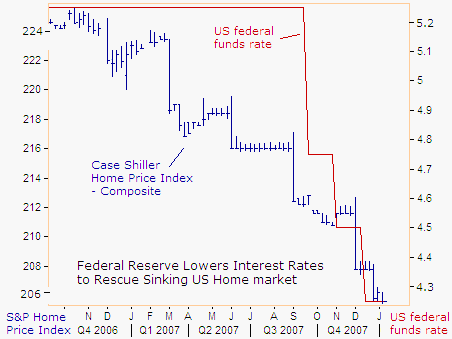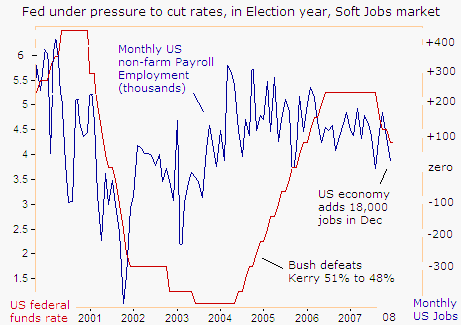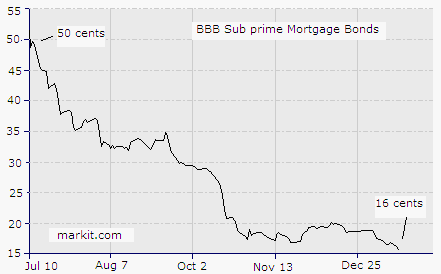|
|||
Federal Reserve Plays Russian Roulette with US$Gary Dorsch In an age where governments of every political stripe distort data to promote their own self interests, it's hardly surprising that they present inflation data in a manner that is best suited to their particular needs. By the same token, it's entirely natural for official inflation data to be wildly at odds with the reality that is faced by consumers and businesses, and to be regarded with utter disbelief. So it wasn't shocking to hear Federal Reserve officials insist last week, that inflation in the United States is under control, before telegraphing another tidal wave of liquidity injections into the US economy in the months ahead. "Stable inflation expectations give the Fed a lot of room for maneuver. If the evidence suggests that substantial policy easing is appropriate, I don't think we're going to face a risk of adverse inflation consequences," said St Louis Fed chief William Poole on Jan 9th. In an election year for the highest office in the land, American politicians from both sides of the isle, are quick to propose all kinds of fiscal stimulus and pork barrel projects to jump start the sputtering US economy. But adding more monetary stimulus to the mix has the potential to ignite hyper-inflation in the US economy, and a speculative attack on the US dollar in the $3.2 trillion a day currency market. "It's difficult enough to make good policy in a complex economy and complex financial system," said Fed chief Ben "B-52" Bernanke on January 11th. "Political considerations will play no role, and I assure you as strongly as I can, that we will be objective and analytical, and we'll do what's right for the economy," he said.  It's now becoming increasing clear, that the only prices the Fed is focusing on these days are home prices and those for toxic sub-prime mortgage debt. The Fed is pegging the federal funds rate in the direction of US home prices, mimicking the Bank of England as an asset targeter. Last week, nearby futures contracts on the Standard & Poor's/Case-Shiller, an index of home prices in the top-10 US cities, fell below the 206-level, or roughly 7% lower from a year ago. Robert Shiller, a Yale University economist, and co-founder of the widely watched house-price index, predicted on Dec 31st, a possibility that the US economy would stumble into a Japanese-style recession, with house prices declining for years. "American real estate values have already lost around $1 trillion. That could easily increase threefold over the next few years. This is a much bigger issue than sub-prime. We are talking trillions of dollars' worth of losses." He noted that Chicago futures markets are pricing in further declines in US home prices, with farther dated contracts on the S&P Shiller Index pointing to losses of up to 14 percent. In the third quarter of 2007, US homeowners withdrew $20 billion less in equity from their homes than in the prior quarter, and since housing prices have continued to tumble, the outlook for cash-outs has continued to dim.  Lenders have also grown more cautious in handing out cash through home equity lines of credit since those loans were failing at their highest rate in ten years during the third quarter. If the housing market continues to sink this year, consumers will have less home equity to convert into cash, which could lead to a big pullback in spending. With consumers struggling with high energy costs and a softening jobs market, the drying up of home equity could usher in an economic recession. Slumping home prices and a softer jobs market, could increase foreclosures on many sub-prime home borrowers, and blow huge craters in the balance sheets of banks and brokers worldwide. Credit Suisse projects 775,000 homes with $143 billion of mortgage debt will go into foreclosure in the next two years. Goldman Sachs estimated that losses in mortgage markets worldwide may reach $726 billion.  Some BBB rated sub-prime mortgage bonds have already tumbled to 16-cents on the dollar from 50-cents last July. AA rated paper isn't faring much better, fetching only 40-cents in the $1.8 trillion sub-prime mortgage market. On January 15th, Citigroup C.n, the nation's largest bank, took a fourth-quarter loss of nearly $10 billion, stemming largely from $18 billion of write-downs of sub-prime mortgages. The deepening gloom in the US financial sector came as Bank of America BAC.n agreed to acquire battered mortgage lender Countrywide Financial CFC.n for $4 billion, to avert one of the biggest collapses due to the toxic sub-prime debt bomb. Merrill Lynch is expected to suffer $15 billion in losses stemming from soured mortgage investments, as the sub-prime debt bomb goes nuclear. Bernanke Signals more Rate cuts in Q'1 With the US economy sinking deeper into the "Stagflation" trap, and credit worries clogging the arteries of the Libor market, Mr Bernanke shouted loud and clear for the whole world to hear on Jan 10th, that the Fed and the US Treasury (the "Plunge Protection Team" - PPT) have decided to exercise the "Greenspan Put" option, and will simply disregard elevated inflationary pressures in the rest of the economy. To read the rest of this document, click on the link below: http://sirchartsalot.com/article.php?id=77 Jan 16, 2008 |
